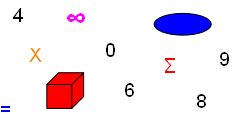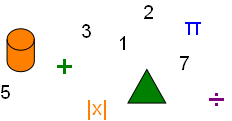



Exponents


Exponents are a convenient and efficient representation of multiplication and division. They are a base number and a superscript. The superscript is the exponent. The magnitude of the exponent, its value, is the power the exponent influences upon the base. The larger the power, the greater the impact on its base.
Let “a” be the base:
a0 = 1
a1 = a
a2 = a × a
a3 = a × a × a
a4 = a × a × a × a
…and continues infinitely.
a0 = 1
a −1 = 1/a
a −2 = 1/a ×1/a
a −3 = 1/a × 1/a × 1/a
a −4 = 1/a × 1/a × 1/a × 1/a
…and continues infinitely.
The superscript exponent tells us how many times to factor its base. That is, how many times the base is multiplied by itself. When an exponent is positive it tells us its base is a numerator, negative tells us its base is a denominator.
Adding Exponents
Let “a” be the base and let “m” and “n” be exponents:
am + n
If a = 3, m = 3 and n = 2:
a3 + 2 = a3 a2 = (a a a) (a a) = a × a × a × a × a = a5
33 + 2 = 35 = (3 × 3 × 3 × 3 × 3) = 243
33 + 2 = 33 32 = (3 × 3 × 3) (3 × 3) = (27) (9) = 243
Adding the exponents greater than 0 of an identical base increases its power.
Math often deals with terms that consist of coefficients and variables. We can not combine variables of different base. An “x” is different than “y”, and so their exponents cannot be combined:
(3 x2 y3) (4 x y5 z2) = (3) (4) x2 x y3 y5 z2 = 12 x 2 + 1 y 3 + 5 z2 = 12 x3 y8 z2
Dividing Exponents
To divide two powers having the same math base when the exponent of the dividend is greater than the exponent of the divisor, subtract the exponent of the divisor from the exponent of the dividend:
am ÷ an = am − n
If m > n and a ≠ 0:
x6 / x2 = x6 − 2 = x4
x6 y / x2 = x6 − 2 y = x4 y
If m < n and a ≠ 0:
x2 / x6 = x2 − 6 = x −4
x2 y / x6 = x2 − 6 y = x −4 y = y / x4
Exponents are widely used in mathematics.
Copyright © DigitMath.com
All Rights Reserved.